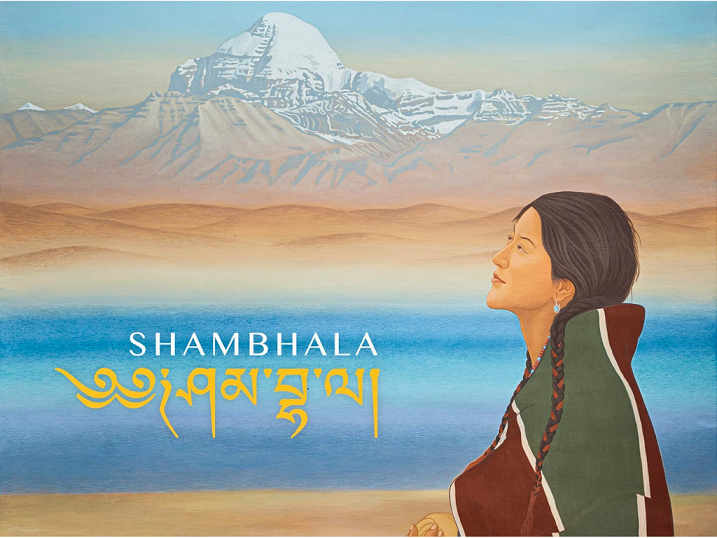SHAMBHALA | NEPALI CINEMA | CULTURE | SPIRITUALISM

It’s rather a late review of a film that premiered 10 days ago in Nepali theatres generating quite a buzz, especially with its premiere attended by Indian cinema figures Nawazuddin Siddiqui and Anurag Kashyap.
Directed by Min Bahadur Bham, who rose to recognition after his previous film Kalo Pothi, the film is Nepal’s official entry for the 97th Academy Awards. The film’s lead, Thinley Lhamo, recently earned the Boccalino d’Oro Prize for Best Acting Performance at the 77th Locarno Film Festival in Switzerland.
The film centres on Pema (Thinley Lhamo), a young woman married to her lover Tashi (Tenjin Dalha), and his two brothers — Karma, a monk (Sonam Topden), and Dawa, a young schoolboy (Karma Wangyal).
Pema’s relationship with them faces challenges when Pema’s enclosed community begins to question her fidelity after her pregnancy while Tashi is out on a month-long trade expedition.
Yet Pema calmly waits for her husband’s return as she grapples with scrutiny and suspicions. Early in the film, Tashi warns his new bride to stay away from a woman who he strongly emphasises has many lovers. The plot unfolds as Pema’s husband doesn’t return home, apparently abandoning her after hearing the rumours. Pema sets out on a quest to find and confront her missing husband, joined by Karma, who is himself caught between his responsibilities as a monk and his obligations as a family man. And as the film tells us, Shambhala refers to a spiritual realm.
Set in Upper Dolpo, a once mysterious and forbidden high-altitude region in western Nepal and known for its practice of Tibetan Buddhism, the film opens with a sweeping shot of Pema’s wedding ceremony. The camera then lingers on the central character Pema capturing her conjugal life with Tashi, her daily household chores, and her care for the young boy until the story unfolds which leads to Pema’s journey to wilderness and self-discovery.
Pema’s character and journey share many similarities with Sita, the Hindu goddess, a central figure of the epic Ramayana, daughter of Bhumi (the earth goddess), a dutiful and loving wife, who experiences exile twice: once with her husband and once at his command when she was pregnant.
Sita goes through the ordeal of Agnipariksha (a trial by fire) to prove her virtue following her first exile. Yet she is imposed a second exile and takes refuge at a hermit’s (Rishi Valmiki) ashram where she gives birth to her twin sons. Later she denounces all the injustices and asks Bhumi to absorb her.
As Sita, Pema endures several trials and tribulations. Pema does so with a subtle strength. Outside, she is gentle and compassionate. Inside, she is spirited. While Director Bham treats the film devoid of the typical oppressive male-oppressed female dynamic and the possible drama that can ensue in such plots. Instead, he emphasises Pema’s journey toward spiritual liberation, conveying it through symbolic imagery.
The landscapes of Upper Dolpo complement the film’s spiritual messaging tied with natural symbolism and aesthetics while maintaining an understated tone throughout. But, prolonged static shots of the towering, silent, and sparsely snow-capped peaks and barren landscapes tend to drag on endlessly and the overall slow-pacing feels drawn out and monotonous.
On the other hand, the film also offers many glimpses of the region’s ethnography. It touches on aspects such as polyandry, trade with Tibet, nomadic lifestyles, horse-racing competition, the tradition of trial-by-archery, spiritual practices, and gender dynamics.
The inclusion of some of these cultural elements however feels more like a display of exoticism rather than a meaningful contribution to the story or development of characters. And as such although the film aims to explore individuals’ struggles and their journey towards spiritual growth (including of Karma), it ends up spreading itself too thin, missing deeper narrative potential.
The film also has notable flaws in its storytelling that may leave viewers feeling confused or unfulfilled.
The polyandry subplot feels directionless. What period is the film set in? How do Pema’s mother and Ram sir easily locate Pema who is in the wilderness? And what’s with the photos Ram sir hands over to Pema? And the abstract ending.
There are moments in the film that seem poised to develop into something truly beautiful, but abrupt cuts disrupt the flow [for instance, when Karma sings]. While the film’s brief dialogues and slow delivery provide depth and enrich the characters, this is limited. Tashi’s love for Pema and her interactions with Karma is conveyed through these subtle exchanges.
When Pema tells Karma that his compliments on her knitting reflect his feelings, it underscores both his emotional openness and her spiritual growth. However, because the characters do not undergo significant evolution in their performances, these dialogues start to feel superficial.
Lhamo’s screen presence is compelling. Yet after a certain point, as a central character and so much screen time, she reveals no emotional layers or signs of internal conflict. This applies to Sonam Topden too. Child actor Karma Wangyal as a mischievous school-going kid and a brat husband is impressive. He infuses the first half with fun and charm. If it were not for his presence, the film could have felt far lengthier and sluggish.
Read More Stories
Kathmandu’s decay: From glorious past to ominous future
Kathmandu: The legend and the legacy Legend about Kathmandus evolution holds that the...
Kathmandu - A crumbling valley!
Valleys and cities should be young, vibrant, inspiring and full of hopes with...
Today’s weather: Monsoon deepens across Nepal, bringing rain, risk, and rising rivers
Monsoon winds have taken hold across Nepal, with cloudy skies and bouts of...